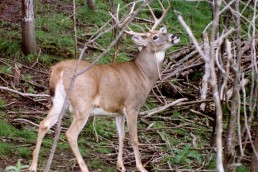Hunting Bucks in November
SHARE THIS POST
Dr. Ken Nordberg has a tip to help you while hunting whitetail bucks in what he considers the most difficult month—November.
During the first half of the month, the largest whitetail bucks (dominant breeding bucks) and smallest (yearlings), will be changing their locations, including trails and feeding areas, almost every 24 hours.
Though older bucks are most vulnerable to skilled stand hunting at any time, they are also the most proficient of whitetails at finding, identifying and avoiding hunters. Unfortunately, most stand hunters do just about everything possible these days to enable such bucks to easily find and identify them, and thereafter avoid them the rest of the hunting season.
Number one on your list of improvements should be to make yourself as difficult as possible for an approaching buck to identify via sight. This is a matter of skillfully using natural cover to adequately conceal yourself from bucks and other deer at locations where they are right now or soon will be.
Doing this, however, requires additional knowledge of what older bucks do throughout November, and using an improved method of traveling on foot to and from stand sites that does not seriously alarm whitetails. This method is also essential when searching on foot for next spots to stand hunt during a hunting season: a current favorite buck feeding area revealed by fresh tracks, and/or droppings made by a mature buck on an adjacent deer trail, for example.
After many years of observing older bucks approaching the many types of blinds I have experimented with, I am convinced they can easily discern straight edges of manmade objects among surrounding natural objects, none of which have straight edges. I have watched too many older bucks (mature does, too) heading my way suddenly halt to stare in my direction, and then stealthily or hurriedly disappear. Older bucks react similarly to blinds with colors, patterns and shapes that do not match surrounding natural objects and foliage. What I finally concluded from these studies is, nothing hides a stand hunter from the eyes of older bucks better than natural, unaltered cover.
Unfortunately, firearm hunters must wear blaze-orange clothing that glows in sunlight, which is very difficult to hide from deer even in dense forest cover. It’s great for safety, but a serious handicap when hunting older bucks. What this means is, if it is your intention to be a successful buck hunter this November, you need take extra precautions to circumvent being easily seen and avoided by deer.
Are you enjoying this post?
You can be among the first to get the latest info on where to go, what to use and how to use it!
Begin by eliminating unnecessary blaze-orange clothing, such as pants, unless your state regulations require it, if you are a member of a hunting gang that only makes drives, if you prefer to move about on foot while hunting where you frequently encounter other hunters, or if you are concerned about the safety of your son or daughter during their first hunting season. In those cases, by all means, insist on wearing blaze-orange pants.
Many years ago, I not only quit wearing my quilted blaze-orange pants (except when it is very cold), but also began wearing black woolen bibs and a camo-blaze-orange jacket and cap. This very significantly improved the number of unsuspecting bucks I began seeing up close. In time, however, older bucks began proving they weren’t fooled much by camo-blaze-orange either, forcing me to begin making sure I was well concealed by natural cover wherever I stand hunt, on the ground or in a tree.
At this point, because I often select a stand site moments before using it for the first time during a hunting season, close to where a mature buck is likely to be located right now, my ground level selections need to be made silently and quickly; and preferably where no preparations are required (other than silently pruning off a few thin tips of intervening branches within reach). This got me thinking that the less I wear that needs to be hidden by natural cover, the better. Which might even make it possible to begin using stand sites where natural cover does not provide 100 percent concealment.
This November, like my three regularly successful sons have been doing for three years, instead of wearing my camo-blaze-orange jacket, I will begin wearing a camo-blaze-orange vest over a natural-camo jacket suitable for bowhunting. Meaning, the only legally-required camo blaze-orange clothing I will then be wearing is my vest and cap—far less to hide from older, sharp-eyed bucks than ever before.
Even seasoned hunters can learn new ways to make their hunts more successful. Find more hunting tips in the fall issues of MidWest Outdoors, available by subscribing on our website.
MWO
SHARE THIS POST
You may also like...
Nothing found.
Did you enjoy this post?
You can be among the first to get the latest info on where to go, what to use and how to use it!
Dr. Ken Nordberg
Based on his 55 years of field research, Dr. Ken Nordberg has written more than 800 magazine articles, 12 books on whitetails—including the famous Whitetail Hunter’s Almanac series—five books on black bear hunting and produced Buck and Bear Hunting School videos. You may peruse his encyclopedic website with whitetail hunting tips: drnordbergondeerhunting.com, his blog: drnordbergondeerhunting.wordpress.com, or social media pages.
